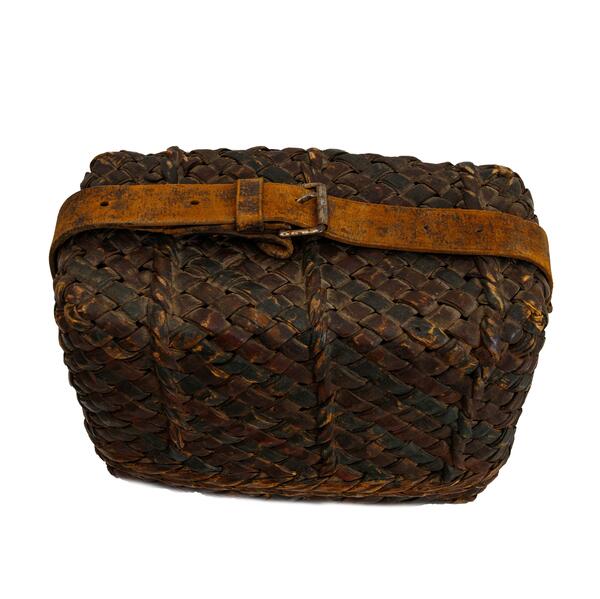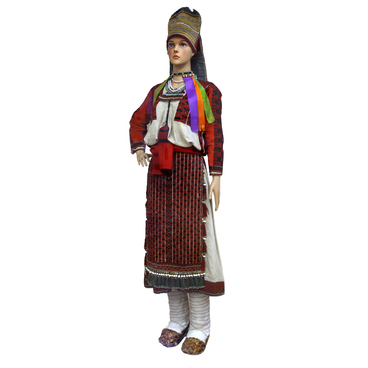The exhibition includes a kepter’, a wicker box made of bast, painted green and brown. There is a record of this exhibit in the museum registration book:
Wicker box
Creation period
mid 19th century
Place of сreation
Penza province
Dimensions
29x19x20 cm
box 27х13,5х19,5 cm; lid 29х19х16 cm
box 27х13,5х19,5 cm; lid 29х19х16 cm
Technique
weaving
Exhibition
3
Open in app#1
Wicker box
#7
#8
Purchased from Vladimir Aleksandrovich Polushkin, residing at 16 Sadovaya St., Saransk, MASSR, in 1976.
#10
Kepters were made not only of bast, but also of twigs of willow, birch bark, and straw. Such a box was used for storing and carrying food. In wicker baskets of different size mushrooms and berries were collected.
Wild berries such as raspberries, blackberries, rowanberries, strawberries, and bird cherry were traditionally gathered by the Mordovians during the summer. Berries were consumed raw, dried for the winter, and jam was made of them. Highbush cranberries were used to make pie filling, and also mixed with wheat. They cooked cereals of this mixture.
Mushrooms were preserved for the winter and then were added to soups or fried with potatoes. The most widespread mushrooms were ceps, yellow boletus, agaric honey, milk mushrooms, and brown cap boletus. Special superstitions and rites were associated with the mushroom hunting. In spring, the first found morel was eaten with salt to be able to find more mushrooms. Also, pieces of bread were hung on the branches of trees: it was believed that if they were pecked by birds, people would certainly be able to gather a lot of mushrooms and berries.
Kepter’ (wicker box) was also used for storing grain, flour, clothing and sewing supplies. The Mokshan people, when going on a trip, took with them shoulder bags, which are bast bags with lids in the form of a rectangular box of two halves, which fit freely one into the other. They were convenient because they could be carried over the shoulder. Wicker shoulder bags were used mainly to carry food products.
Kepter’ (wicker box) was made of birch or linden bast. The bast is the inner part of the bark of young linden and other deciduous trees. To get bast, whole groups of peasant men went to the forest. The best time for the bast is spring, when the first leaves on the linden trees begin to blossom. The trunk of a young tree had to be thinner than a tea glass — “like a shot glass” as the old masters used to say and that meant “very thin or narrow”.
A special sharp wooden tool was used to remove the bast. Such a procedure caused considerable damage to the linden tree, and most often it died. Ready bast bunches had to be tied up and dried, which was usually done by hanging them in the haylofts or in the attic. Before wickerwork, the bast was soaked in warm water for a whole day, the bark was removed and only the bast was left.
Wild berries such as raspberries, blackberries, rowanberries, strawberries, and bird cherry were traditionally gathered by the Mordovians during the summer. Berries were consumed raw, dried for the winter, and jam was made of them. Highbush cranberries were used to make pie filling, and also mixed with wheat. They cooked cereals of this mixture.
Mushrooms were preserved for the winter and then were added to soups or fried with potatoes. The most widespread mushrooms were ceps, yellow boletus, agaric honey, milk mushrooms, and brown cap boletus. Special superstitions and rites were associated with the mushroom hunting. In spring, the first found morel was eaten with salt to be able to find more mushrooms. Also, pieces of bread were hung on the branches of trees: it was believed that if they were pecked by birds, people would certainly be able to gather a lot of mushrooms and berries.
Kepter’ (wicker box) was also used for storing grain, flour, clothing and sewing supplies. The Mokshan people, when going on a trip, took with them shoulder bags, which are bast bags with lids in the form of a rectangular box of two halves, which fit freely one into the other. They were convenient because they could be carried over the shoulder. Wicker shoulder bags were used mainly to carry food products.
Kepter’ (wicker box) was made of birch or linden bast. The bast is the inner part of the bark of young linden and other deciduous trees. To get bast, whole groups of peasant men went to the forest. The best time for the bast is spring, when the first leaves on the linden trees begin to blossom. The trunk of a young tree had to be thinner than a tea glass — “like a shot glass” as the old masters used to say and that meant “very thin or narrow”.
A special sharp wooden tool was used to remove the bast. Such a procedure caused considerable damage to the linden tree, and most often it died. Ready bast bunches had to be tied up and dried, which was usually done by hanging them in the haylofts or in the attic. Before wickerwork, the bast was soaked in warm water for a whole day, the bark was removed and only the bast was left.
#6
Министерство культуры РФ
read morehide
00:00
00:00
1x
Wicker box
Creation period
mid 19th century
Place of сreation
Penza province
Dimensions
29x19x20 cm
box 27х13,5х19,5 cm; lid 29х19х16 cm
box 27х13,5х19,5 cm; lid 29х19х16 cm
Technique
weaving
Exhibition
3
Open in app
Share



